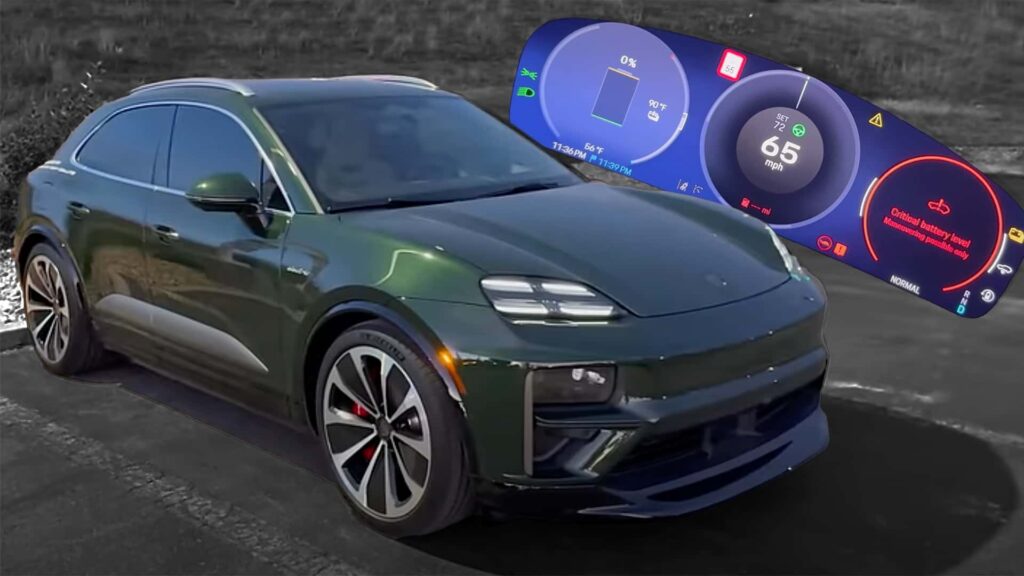The Porsche Macan Turbo Electric recently made headlines for its impressive performance during a 70 mph highway driving test. The vehicle managed to cover a distance of 290 miles before finally running out of power. What makes this feat even more remarkable is the fact that it exceeded its EPA-claimed range of 288 miles, despite being equipped with 22-inch wheels, the largest available for the model.
The test was conducted by Kyle from Out Of Spec Reviews, who pushed the Macan Turbo to its limits in order to gauge its real-world range capabilities. Driving at a constant speed of 70 mph on the highway, Kyle managed to extract every last bit of energy from the vehicle’s 95-kilowatt-hour battery. When the Macan finally came to a stop, it needed to be pushed for the last few feet in order to reach the charging station.
Porsche’s official EPA range estimate for the base Macan 4 is 308 miles, which drops to 288 miles for the high-performance Macan Turbo model. These numbers position the Macan at the upper end of the electric crossover/SUV range spectrum. With Porsche’s expertise in electric vehicle technology, particularly from the success of the Taycan, it is expected that the electric Macan will perform well in real-world driving conditions.
Similar to the Taycan, the Macan operates at up to 800 volts, making it more efficient and quicker at charging compared to lower-voltage EVs. However, the Macan is not mechanically related to the gas-powered Taycan, as it utilizes the same PPE platform as the Audi A6 E-Tron and Audi Q6 E-Tron.
The test results with the Macan Turbo demonstrate that it is possible to achieve impressive range figures even with larger, less aerodynamic wheels. This bodes well for the more efficient Macan 4 model, which should have no trouble reaching its claimed range of around 330 miles with the base 20-inch wheels.
In conclusion, the test highlights the importance of conducting real-world range tests to determine an EV’s true capabilities. While advertised range numbers are important for buyers, actual driving conditions can significantly impact the vehicle’s performance. By pushing the Macan Turbo to its limits, Kyle was able to demonstrate its impressive range and performance, setting a high standard for electric SUVs in the market. Electric vehicles (EVs) have become increasingly popular in recent years as more and more people look for environmentally friendly transportation options. One of the key components of an EV is the battery pack, which determines the range and performance of the vehicle. However, the performance of the battery pack can vary significantly from one EV to another, and it is important to verify the specifics on a case-by-case basis.
The battery pack of an EV is made up of individual battery cells that store and release energy to power the vehicle. The performance of the battery pack is determined by factors such as the type of battery cells used, the size of the pack, and the management system that controls the flow of energy. Some EVs may have a larger buffer in their battery pack, which allows for more energy storage and better performance.
It is important to note that the performance of an EV’s battery pack can vary depending on how it is used and maintained. Factors such as temperature, driving habits, and charging practices can all impact the overall performance and longevity of the battery pack. For example, extreme temperatures can affect the efficiency of the battery cells and reduce the overall range of the vehicle.
In order to maximize the performance of an EV’s battery pack, it is important to follow the manufacturer’s guidelines for charging and maintenance. This may include avoiding frequent fast charging, keeping the battery pack within a certain temperature range, and avoiding deep discharges. By taking care of the battery pack, EV owners can ensure that their vehicle performs optimally and has a long lifespan.
In conclusion, the performance of an EV’s battery pack can vary significantly depending on a number of factors. It is important to verify the specifics of the battery pack on a case-by-case basis and to follow the manufacturer’s guidelines for charging and maintenance. By taking care of the battery pack, EV owners can ensure that their vehicle performs well and has a long lifespan.

